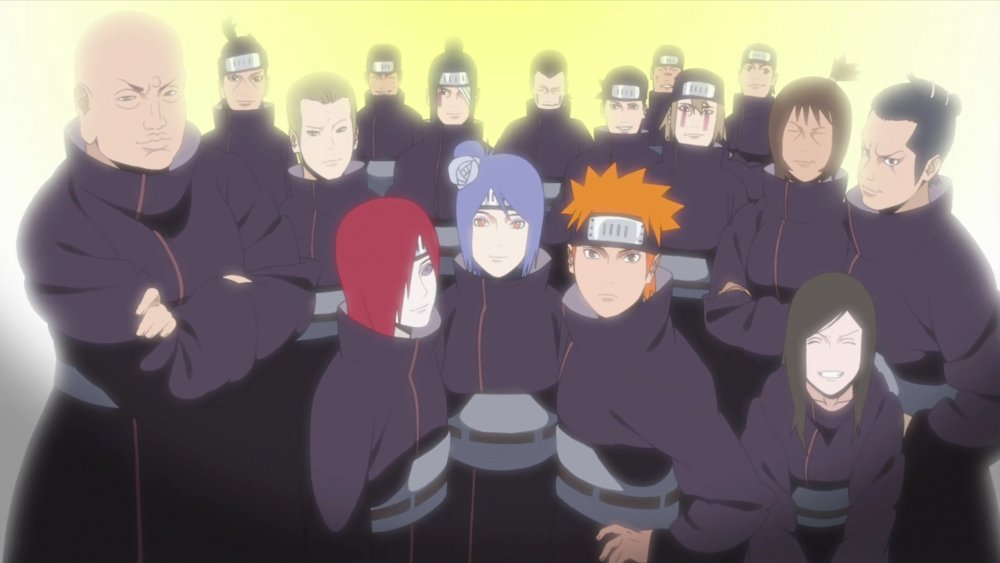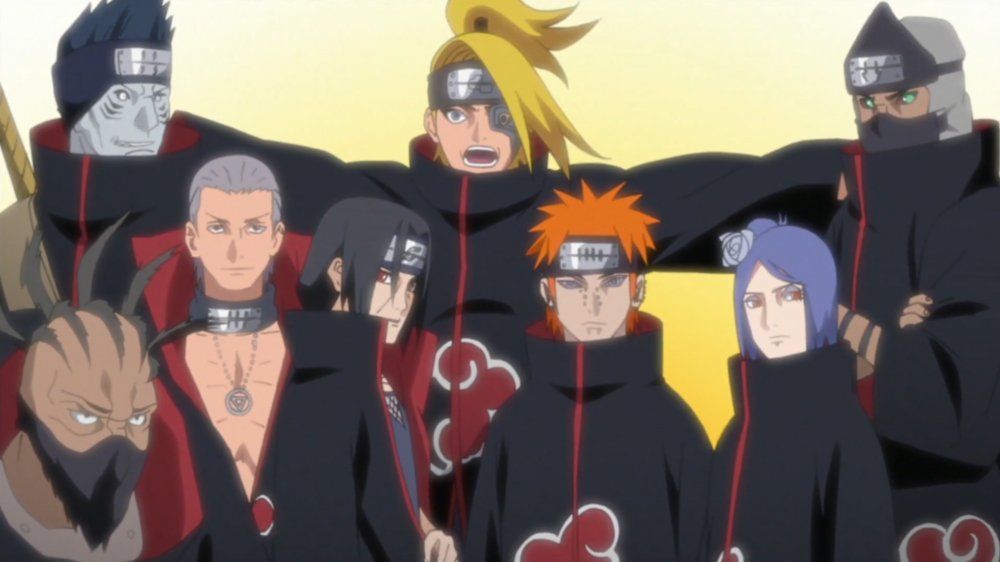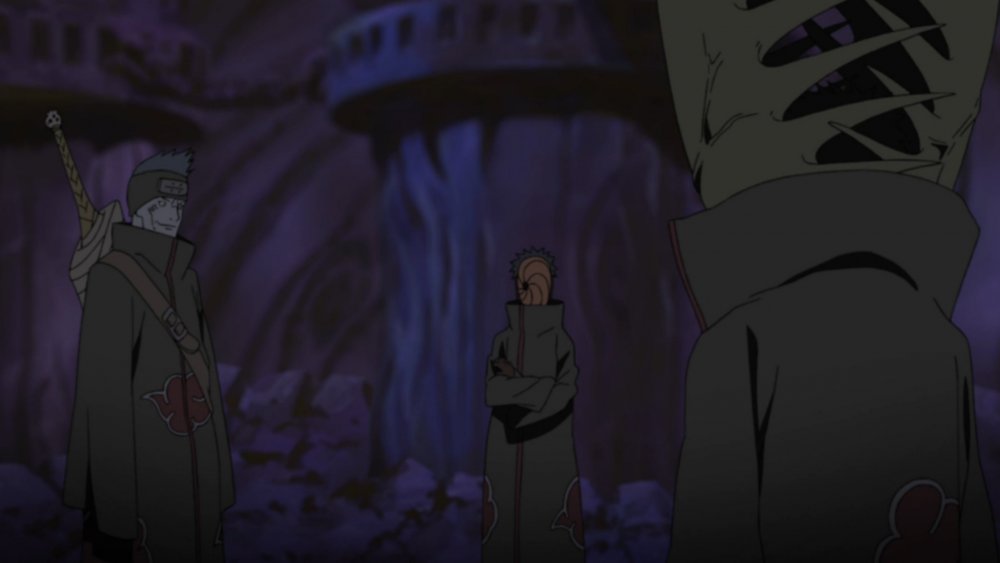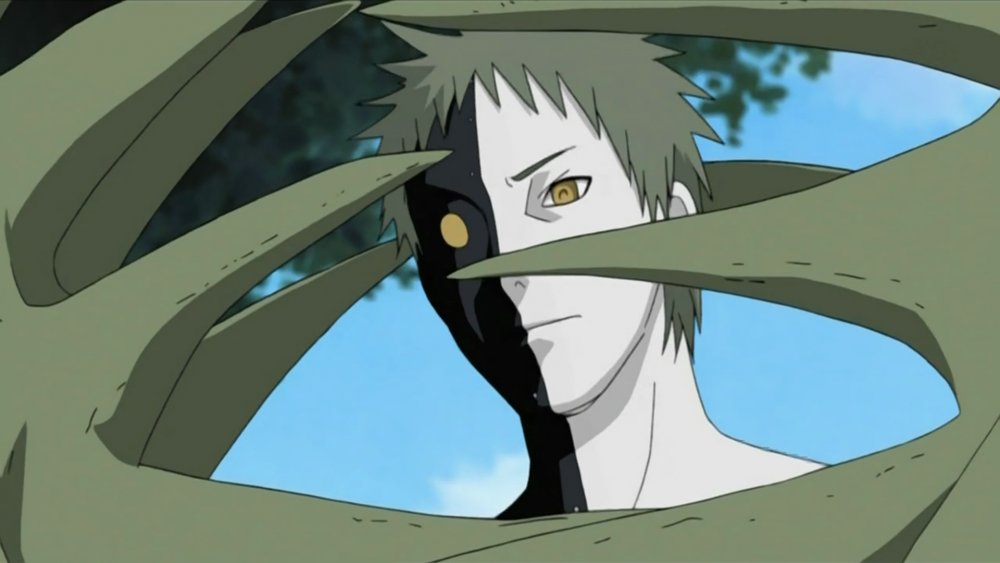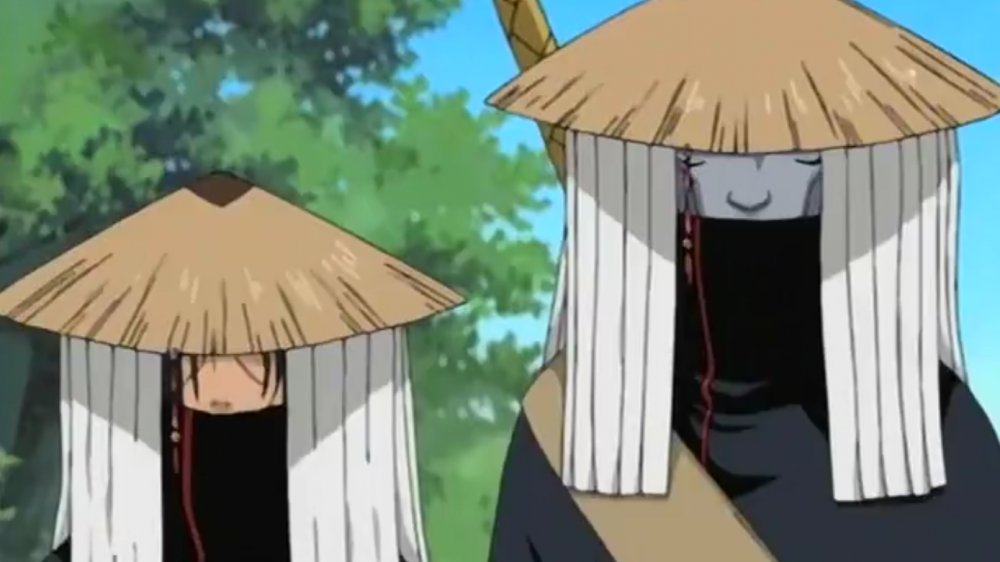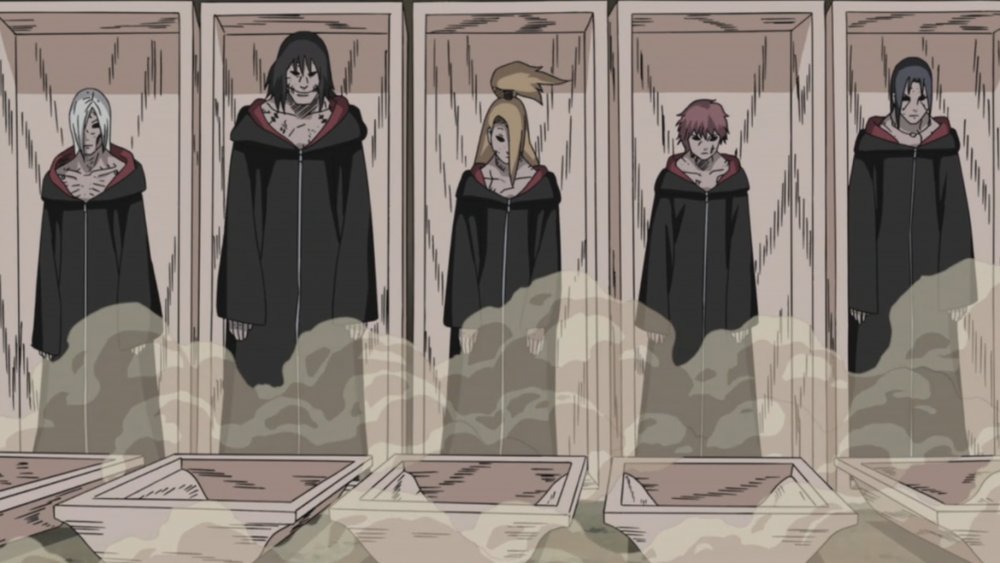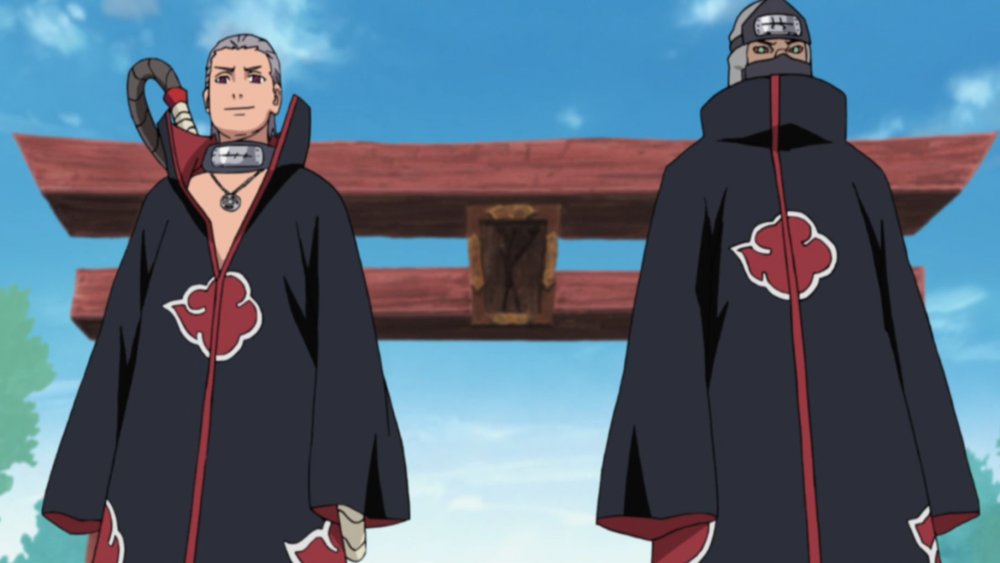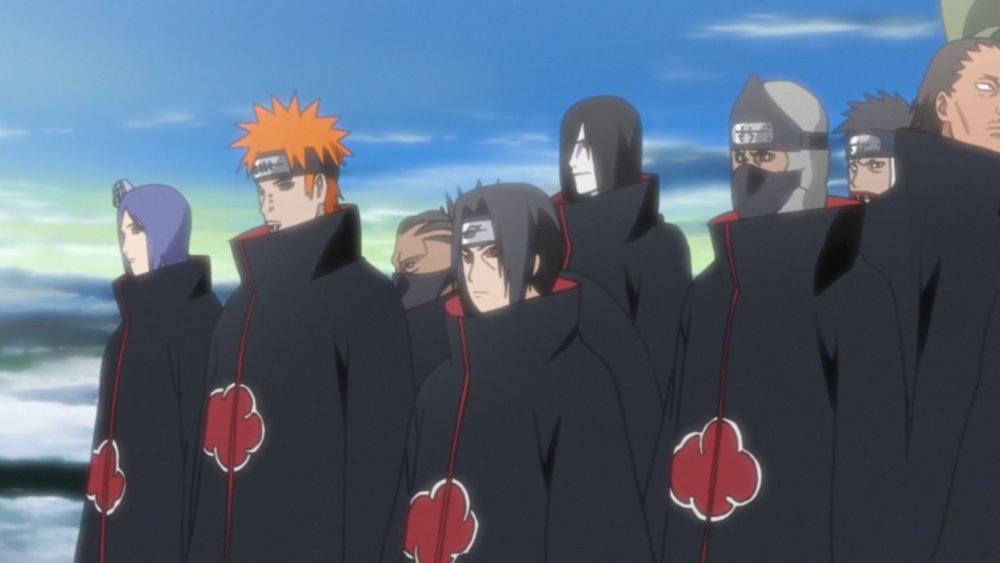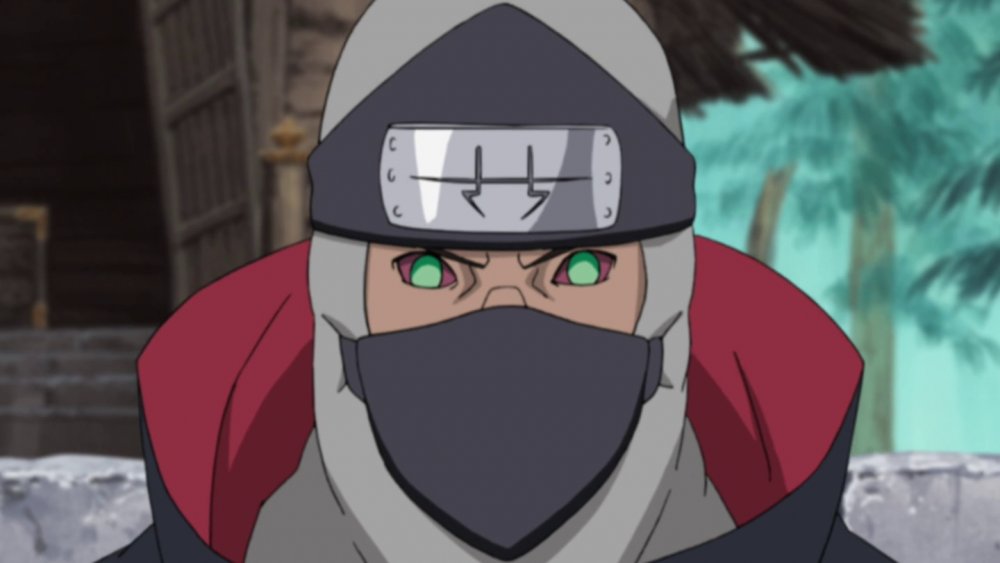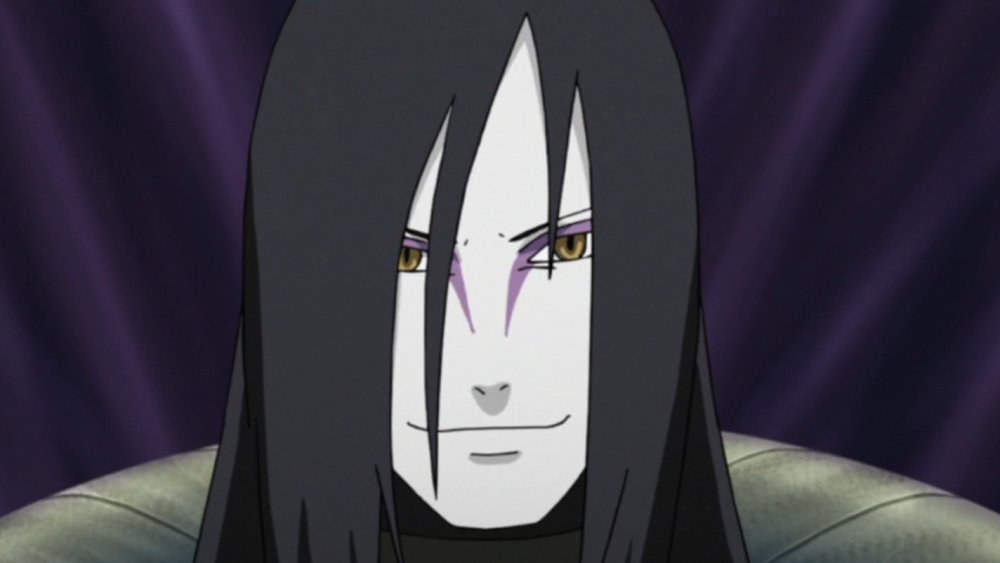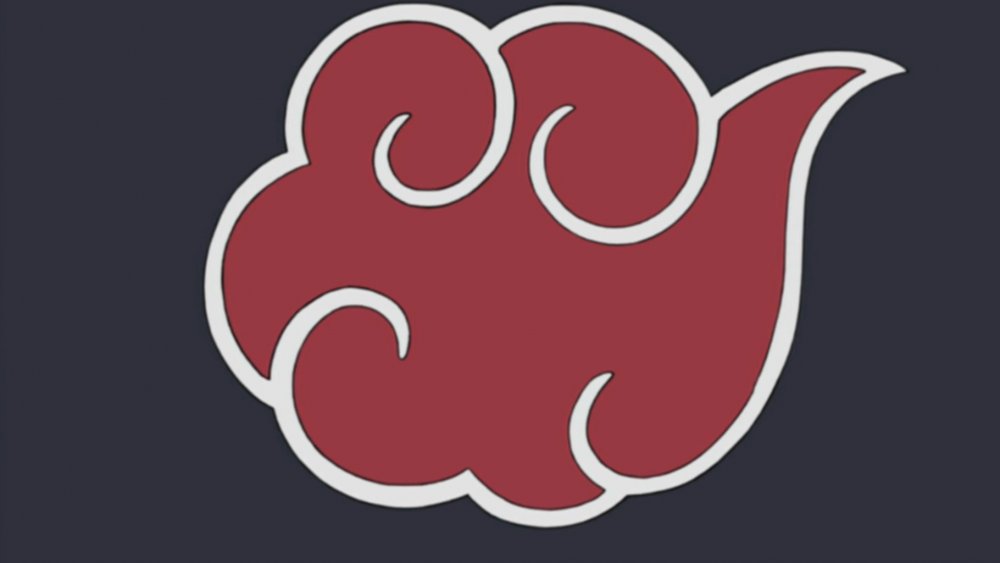The Untold Truth Of The Akatsuki From Naruto
The Akatsuki are the looming threat hanging over much of Naruto's 700-some-odd episodes. Given their central role in the series' main conflict and the many half-hours the show took to explore them, you'd think we know everything there is to know about the mysterious organization of rogue ninjas. We know their origin. We've seen them defeated. We're well aware of all their tragic backstories.
However, between the expansive manga, prose novels, video games, and sundry other Naruto installments, there are plenty of nooks and crannies containing hidden Akatsuki knowledge. Generations of Akatsuki leaders have come and gone, plots have been devised and discarded, and characters concealing dramatic depths have been mentioned once, then never seen again. There is, simply, so much to the Naruto story that even the most diehard fan might be missing major chunks of knowledge. We're here to rectify that. This the untold truth of the Akatsuki, Naruto's shadowy bad guys.
A brief introduction
Naruto begins in a time of relative peace, after the world has moved from its era of mythical creatures and feudalism to one of conglomerated power. The "Five Great Nations" now exist, all of which maintain their power and stability through armies of ninjas who have mastered chakra-based fighting. They use this power to launch various "jutsu," energy-based attacks that can come in the form of element-based assaults or illusions.
The extreme power of these nations and their warriors leads to something akin to the Cold War. Constant struggle falls by the wayside, with only occasional "great wars" breaking the peace. The series picks up a generation after the Third Shinobi War, a brutal conflict in which untold numbers of fighters died.
The Akatsuki are a splinter group who exist outside of this established order. Their ranks are made up of defectors from the great nations. Because of the intense loyalty most soldiers feel towards their home nation, the deserters who make up the Akatsuki are looked upon with extreme disdain. They have only each other to rely on.
An understandable mission
Though the Akatsuki are widely reviled, viewers are given the opportunity to empathize with the villains. The Akatsuki were formed by a powerful fighter named Yahiko who was tired of seeing his country ravaged in the world's conflicts. Like Naruto, he was an orphan, his parents casualties of the Second Shinobi World War. Alongside other orphans of that conflict, he founded the splinter group as a means to end the violent spasms that wracked the world.
Yahiko's time as leader came to an end, however, and others stepped up to head the Akatsuki according to their own desires. Some leaders attempted to end the wars by economically undermining countries, so that they could not afford to create conflict. Others attempted to unite the nations of the world through conquest. The end goal was always the same, however: ending world wars.
Given this noble cause, and the aura of cool around all fictional criminal organizations, plenty of "Killmonger was right"-style discourse has cropped up around the Akatsuki. While they are nearly entirely liquidated during the show's own Shinobi War, the group still has its defenders.
They weren't wiped out entirely
Though the Akatsuki are no longer a threat to the characters of Naruto, two of its longest-serving and most devoted members are still alive. Black Zetsu, a non-human member of the Akatsuki who was working to revive an ancient being, is sealed away but still very much alive. Hidan, an immortal human member of the Akatsuki, is around as well. He is buried alive by Shikamaru Nara but vows revenge with his last breath above ground. He tells Shikamaru that the world will never be truly safe from him, and said that he'll find a way to wreak havoc once more. "I'll never die. Even if you destroy my body, and I'm left with nothing but my head," he promises vengefully. "I'll escape somehow and when I do, I'll find you and bite your throat out!" As long as these two endure — and they can endure for quite a while — the shadow of the Akatsuki remains thrown upon the world.
An alternate timeline
In spite of their undying devotion to villainy, there exists a timeline where the Akatsuki are not a world-ending cult of powerful shinobi. Road to Ninja: Naruto the Movie sees Naruto and Sasuke trapped in the test version of the Akatsuki's dream-state world, created by Akatsuki leader Tobi. There, they encounter an Akatsuki that acts as a neutral mercenary force.
These Akatsuki of the "Genjustu World" are able to make their living in the same way the Five Great Nations fuel their own economies: Renting out their services as ninjas to other countries and people in need of escorts. The fact that they don't have to resort to criminal activity to stay afloat, and the relative ease with which they move through this fictional world, leads to them being held in much higher standing by the world at large. The Akatsuki of the dream world are still largely loyal to their home countries, they just refuse to work for the government, instead taking on their own contracts. In an unforgettable moment, the Akatsuki of the Genjutsu World even fight alongside Naruto. A twist on the tale to be certain, and one not soon forgotten by fans.
They were meant to be monsters
Black Zetsu is monstrous and inhuman, a living manifestation of a deranged god-figure's will to keep on living. Still, Zetsu is allowed to join this band of misfits and warp them to its own ends — namely, reviving the Princess Kaguya Ōtsutsuki. While Zetsu is the only "monster" in the group, creator Masashi Kishimoto reveals in the companion book Sha no Sho that he originally intended for all of the Akatsuki to be inhuman creatures. Though he abandoned this idea once he sat down to write, it can be seen in Zetsu's inclusion, and the fact that all members of the group have something that makes them slightly more than human. Deidara's design gives him mouths on his hands. Pain can barely be considered a living person. One of the member's is a living puppet, another is a zombie. Kisame is drawn as a half-shark with gills under his eyes and blue skin. The idea to make them outright monsters might have been scrapped, but the members of the Akatsuki are still plenty monstrous.
Real-world analogues
There are echoes of real world religious teachings in the codes followed by various members of the Akatsaki. The immortal Hidan, for example, is an experiment by an in-world cult known as Jashinism. The followers of the god Jashin believe that their deity demands chaos, pain and destruction. Hidan is granted immortality by Jashin through a series of ritual sacrifices and prays to his god before every fight. He hopes that he can, as ever, grant Jashin another death.
While not entirely one-to-one, Jashinism bears a notable resemblance to India's rumored Thuggee cult. Though the mysterious group was likely a colonial fiction maintained by the British, the story remains part of the global imagination. Said to have been a murderous band of outlaws, the thieves of the Thugee were said to worship deities of destruction, much like the followers of Jashin.
A much clearer connection comes from the Six Paths of Pain, developed by Nagato, one of the Akatsuki's founders. A soul travels the paths after death before being reincarnated, the pleasantness of that path based upon accumulated karma. The paths are Deva, Asura, Human, Animal, Preta and Naraka. This is directly taken from the six realms of rebirth in Buddhism. To walk any of these paths means that you have not attained enlightenment and broken free of the cycle of reincarnation. Only in Naruto, however, is this applicable to martial arts.
Uchiha connection
The story of the Uchiha clan is deeply tragic. They helped found Konohagakure, the village that serves as the series' setting, and have existed as one of its noble houses for generations. But that success and status made them isolated and arrogant, and the clan's leaders saw less and less of themselves when they looked upon the affairs of the village. They plotted a coup to overthrow their nation's leadership and Itachi Uchiha was given an awful choice: He could either kill his entire clan while sparing his younger brother or see the entire clan wiped out for treason. He chose the latter.
Because of this tragedy and Itachi's usefulness as a well-known criminal, all three survivors of the Uchihas' downfall work within the Akatsuki at some point. Itachi uses his status as an outcast to be accepted into the Akatsuki's ranks. Sasuke, in contrast, is so disillusioned by the murders that he works on the Akatsuki's behalf. He kills Itachi, only to learn from Akatsuki member Tobi that Itachi was working under orders from the government. Because of this, he comes around to his dead clan's way of thinking and wants to see the village destroyed. He joins the Akatsuki to marshal the manpower necessary.
There's a lot more to Kakuzu
Kakuzu's character is barely explored in the anime series, but in the manga, he gets a much more satisfying arc. All of the members of the Akatsuki have turned on their homes in some way but, outside of Itachi Uchiha, very few of them did it in as dramatic a fashion as Kakuzu.
Kakuzu is a shinobi who makes use of an incredibly gruesome technique: He rips out the hearts of his defeated enemies and uses them to preserve his own life. After failing in an assassination attempt, his village jails him — and ensures their own destruction. He breaks free and unleashes bloody revenge on his home, killing all of the village's elders. Much like Naruto does in early episodes to learn his Shadow Clone technique, Kakuzu steals his village's scroll of forbidden jutsu. This is where he learns that he can gain power by ripping out the hearts of others. His first test case? The villagers.
Insane devotion
It's not hard to see why the members of the Akatsuki tend to stay in the group until their death. Once you've been branded as a traitor to the order of the world, it's hard for anyone to trust you ever again — the red-and-black cloak is, in many ways, donned for life.
Though plenty of Aktasuki agents join the group under duress and extreme pressure, there is the whole matter of their extremely understandable cause: ending all war. Such a grand scheme inspires insane devotion, with many members taking their own lives when they felt that they had failed. In fact, only two members of the Akatsuki ever leave the organization alive in its entire run. Founding member Konan leaves after her co-founders die, and the opportunistic Orochimaru leaves once he realizes his goal of stealing a new body for himself could not be found in the Akatsuki. That's a pretty good track record for a group full of bad guys.
What's in a name?
Much of what the Akatsuki believe is found in their name. It translates to "Dawn" or "Daybreak," nodding toward the idea that they wish to bring forth a new world where war is impossible.
Written as "Aka Tsuki," however, it translates to "red moon," a reference to the technique that a later leader hopes to cast upon the world The red moon in this case refers to the Infinite Tsukuyomi, a jutsu that places the entire world in a dreamscape without conflict. The chakra of the people trapped within can be drained for energy, in something akin to the battery setup of The Matrix.
The Akatsuki are ultimately unsuccessful in creating long-term change, but it can be argued that most Akatsuki leaders get what they want, at least briefly. Zetsu brings back its master, and the Infinite Tsukuyomi is briefly cast. However, they are ultimately stomped out by a coalition of the world's greatest fighters.
